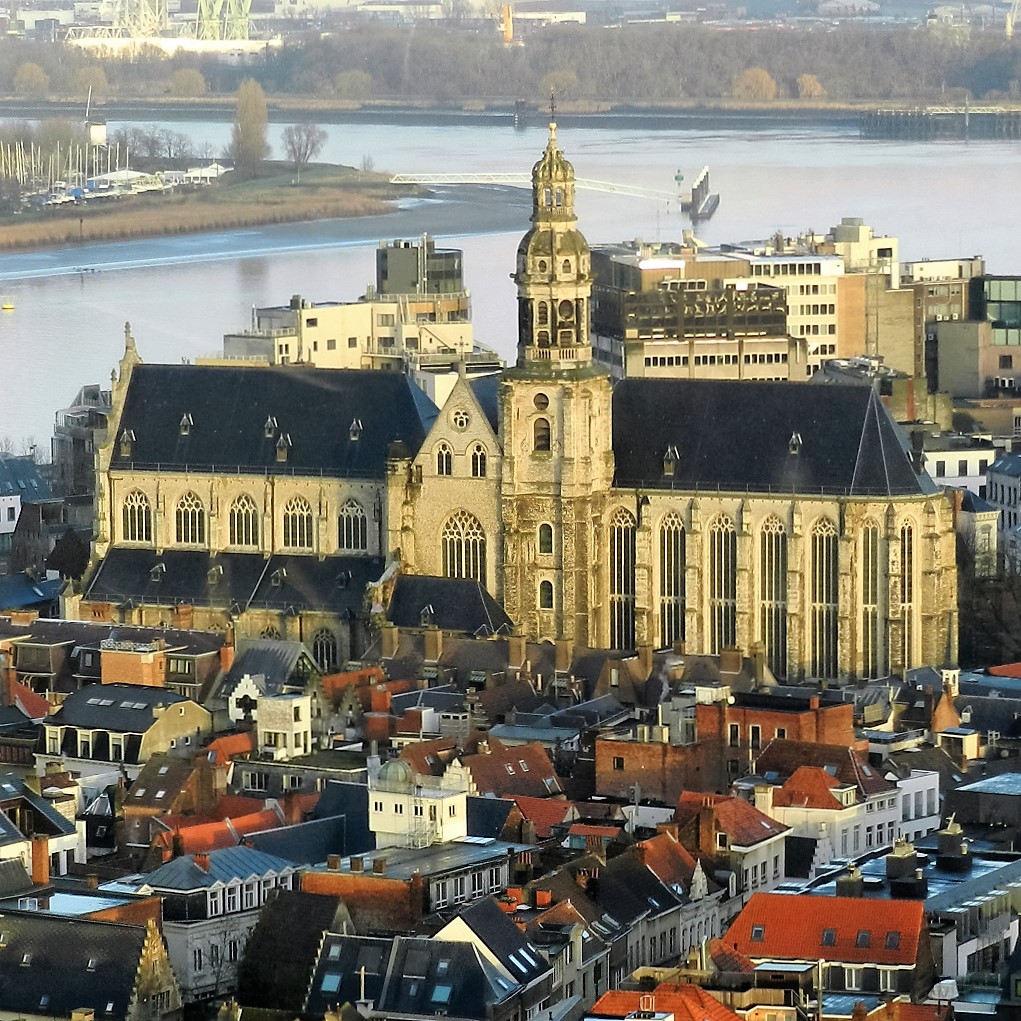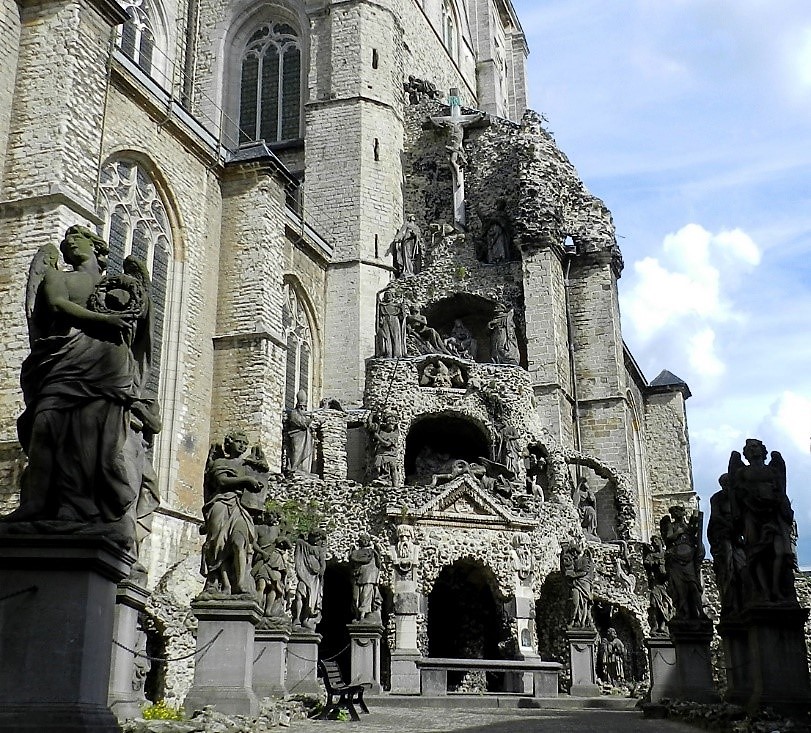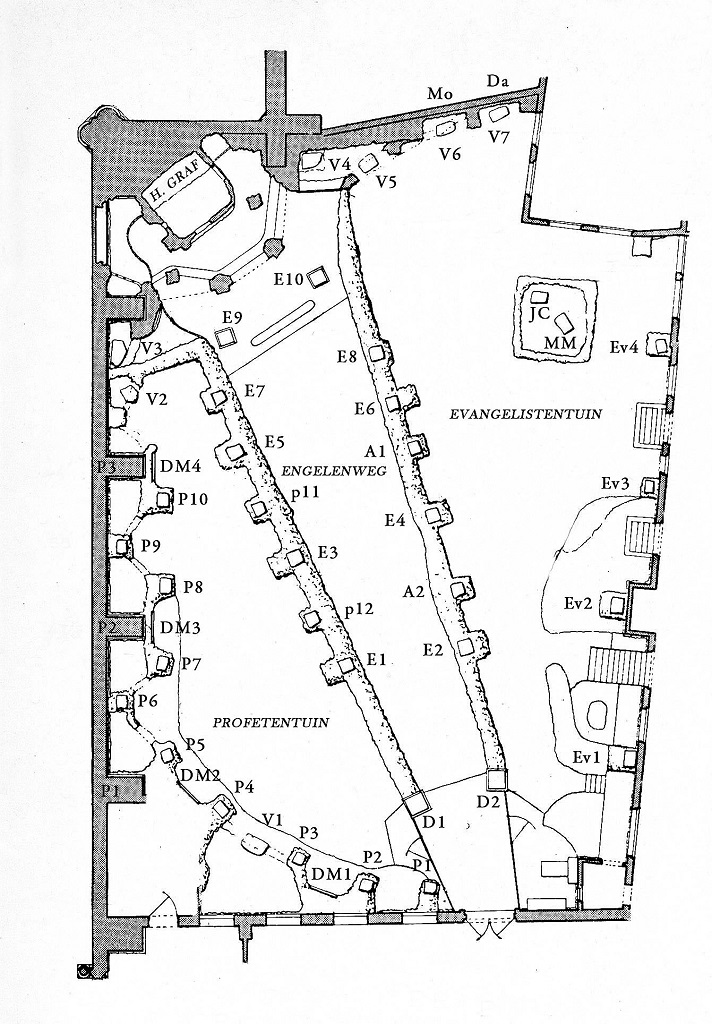Saint Paul’s, the Antwerp Dominican church, a revelation
The Calvary garden: on a pilgrimage 'round the corner'
The Dominicans and the pelgrimage to Jerusalem
For many a Christian the pilgrimage to the Holy Land is a goal in life. In 17th century Antwerp the Dominicans took the lead in the promotion of this pilgrimage. Within the Brotherhood of the Rosary they founded the Fellowship of Palmers. The last ones to visit the Holy Land at the end of that century were the two Ketwigh brothers, both Antwerp Dominicans. Because the Holy Land had become inaccessible due to the advancing Ottoman troops Dominicus (Domien) van Ketwigh conceived the plan to convert the graveyard next to the church into a contemplative statue garden evoking Jerusalem. The burial function of the churchyard was to be preserved. So this Baroque creation was meant to be a kind of spiritual ersatz good. By seeing Jesus’ suffering, death and resurrectionThis is the core of the Christian faith, namely that Jesus rose from the grave on the third day after his death on the cross and lives on. This is celebrated at Easter. impersonated life size, the spectator can call these mysteries of faith to mind more vigorously and experience them more deeply. Already before 1699 Willem I Kerricx drew the first design for the ‘hill’, but it took nearly half a century to have the entire project realized. For this cause until 1741 an appeal was made to several Antwerp Baroque sculptors including Jan Claudius De Cock, Willem I Kerricx and Willem-Ignatius Kerricx, Jan Pieter I van Baurscheit, Michiel I van der Voort and Alexander Van Papenhoven.
Although the dominant Calvary lends its name to the entire garden of the former graveyard, it is in fact also a garden of resurrection, as Jesus’ rising from the dead is brought into vision ‘live’ by His encounter with Mary Magdalene in the garden! Moreover the prophets foretell Jesus’ suffering as well as His resurrection. Whoever was involved in Jesus’ sacrifice of love by His crucifixion and His triumph over death, either as a direct witness, a prophet or as a worshipped pious person, has been given a place here. By the thematic positioning of the statues and by the lively dialogue of some groups of statues this remarkable ensemble looks somewhat like an open air theatre.
Four Dominicans, who were palmers themselves, carrying rosaries, accompany the visitors. To illustrate the destination of their fellowship, they hold shields with on them the Christian escutcheon of Jerusalem, while palms refer to the pilgrims’ custom of entering their hometowns triumphantly with this ‘piece of evidence’.
 At the beginning of the path two beatified Dominicans invite the visitor to join them on their journey by means of the texts on the rim of their shields. On the left there is Jordan of Saxony (D1), who succeeded Dominicus to be the second magister-general of the order. In 1237 however he was killed in a shipwreck when coming back from the Holy Land. He recommends the visit with a verse from the psalms: “AENBIDT OP SYNEN HYLIGHEN BERGH. Ps: 98.” [Worship on His Holy Mountain] (Ps. 99:9). To the right there is the Portuguese Gondisalvus of Amarante (1187-1259) (D2), who, after a stay in Palestine for over ten years, became a hermitA person who lives alone and isolated from the world in order to live a sober and pious life. The home of a hermit is called “hermitage”. and afterwards a Dominican. On Gundisalvus’ shield there is: “SYN GRAF SAL GLORIEUS WESEN ISA : II” [His tomb shall be glorious] (Isaiah 11:10).
At the beginning of the path two beatified Dominicans invite the visitor to join them on their journey by means of the texts on the rim of their shields. On the left there is Jordan of Saxony (D1), who succeeded Dominicus to be the second magister-general of the order. In 1237 however he was killed in a shipwreck when coming back from the Holy Land. He recommends the visit with a verse from the psalms: “AENBIDT OP SYNEN HYLIGHEN BERGH. Ps: 98.” [Worship on His Holy Mountain] (Ps. 99:9). To the right there is the Portuguese Gondisalvus of Amarante (1187-1259) (D2), who, after a stay in Palestine for over ten years, became a hermitA person who lives alone and isolated from the world in order to live a sober and pious life. The home of a hermit is called “hermitage”. and afterwards a Dominican. On Gundisalvus’ shield there is: “SYN GRAF SAL GLORIEUS WESEN ISA : II” [His tomb shall be glorious] (Isaiah 11:10).
On top of the hill, on the terrace underneath the cross, two fathers are preaching. They are the co-founders of the fellowship of the palmers: Domien Vanden Boom (D3), on the left, and the crippled Jaak Pussens (D4) on the right.

Floorplan of the calvary garden
| Dominicans | Apostles | |
| D1 Jordan of Saxony | A1 Peter | |
| D2 Gundisalvus of Amarante | A2 Paul | |
| D3 Domien Vanden Boom | ||
| D4 Jaak Pussens | Evangelists | |
| Ev1 Matthew | ||
| Angels | Ev2 John | |
| E1 crown of thorns | Ev3 Luke | |
| E2 image five wounds | Ev4 Mark | |
| E3 sponge and name board ‘INRI’ | ||
| E4 seamless robe and dice | Minor prophets (Latin inscriptions) | |
| E5 cross | p1 Hosea (Ozeas) | |
| E6 ladder | p2 Joel (Ioel) | |
| E7 shroud | p3 Amos (Amos) | |
| E8 scourge and ropes | p4 Obadiah (Abdias) | |
| E9 Veronica’s veilHeadgear worn by female religious. Until the Second Vatican Council, all nuns wore wimples, which covered the entire hair and neck. Nowadays, the veil is usually worn on the hair. | p5 Jonah (Jonas) | |
| E10 whipping post and crown of thorns, (nails, whip, dice) | p6 Habakkuk (Habacuc) | |
| p7 Micah (Michaea) | ||
| Sorrowful Mysteries, Tomb and Resurrection | p8 Nahum (Nahum) | |
| DM1 Death agony | p9 Haggai (Aggaeus) | |
| DM2 Flogging | p10 Malachi (Malachias) | |
| DM3 Crowning with thorns | p11 Zephanaiah (Sophonias) | |
| DM4 Bearing of the Cross | p12 Zachariah (Zacharias) | |
| Holy Grave (above it Crucifixion and Pietà) | ||
| JC – MM: Jesus appears to Mary Magdalene | Major prophets | |
| P1 Isaiah (Isaias) | ||
| Worshippers | P2 Ezekiel (Ezechiël) | |
| V1 Empress Helena | P3 Daniel (Daniël) | |
| V2 Mary of Egypt | P4 Jeremiah (Jeremias) | |
| V3 Longinus | ||
| V4 Peter and the crowing rooster | Old TestamentPart of the Bible with texts from before the birth of Jesus. | |
| V5 Pelagia | Mo Moses | |
| V6 Jerome | Da King David | |
| V7 Eustochium |



